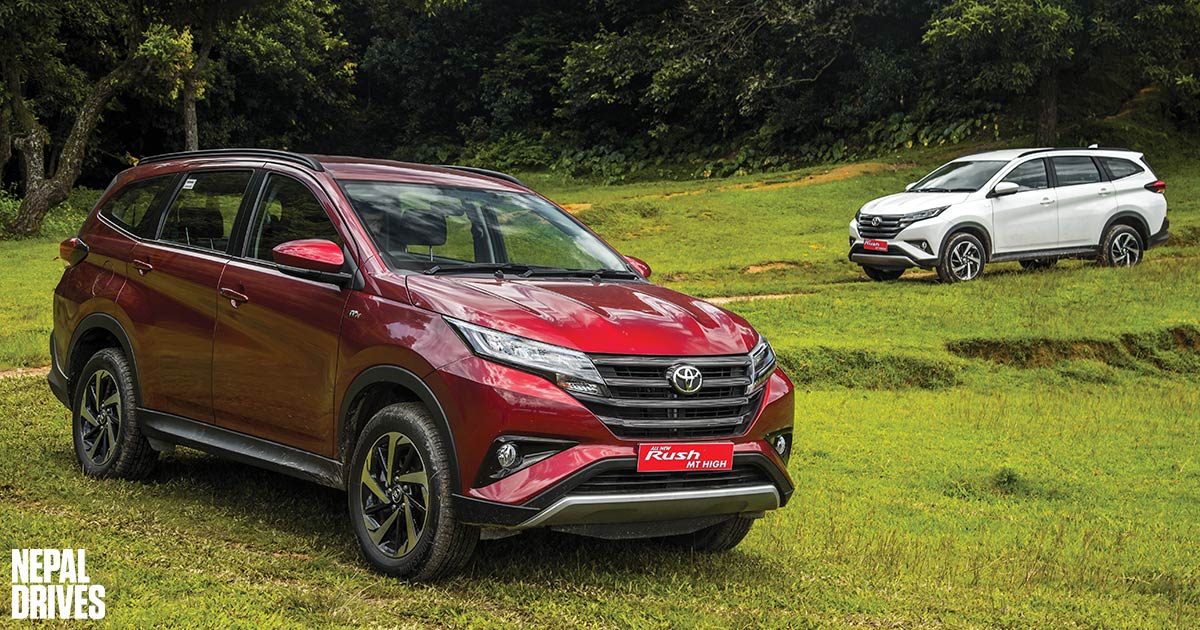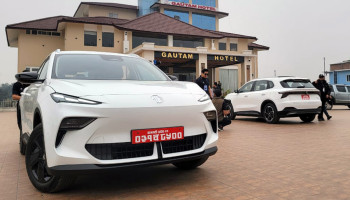There isn’t a thin line between MPVs and SUVs. They are two completely separate segments of the auto industry that cater to two completely different schools of thoughts. Both schools of thoughts stand on two opposing sides of the spectrum. One likes to be rugged, take on harsh terrain, and take you further once the road ends. The other is more docile, carries people around in larger groups and in more comfort, and will prefer it if your holiday getaway has a tarmac driveway leading up to it. What we’re saying here is, SUVs and MPVs are as close to being similar to a banana is akin to a carrot. EXTERIORStraight off the bat, you can see traces of the MPV DNA in the exterior of the Rush. The silhouette is unmistakably reminiscent of a car built to comfortably accommodate more people than a normal car. But, don’t let that fool you, it is by no means just another boring MPV. On the contrary, it is a stylish piece of work to look at.[gallery size="full" ids="6572,6571,6570,6573"]Toyota has made sure the Rush won’t be looked down upon. Aggressive body lines and deliberately smooth curves mix well to create a balanced design. Similar design cues are used well throughout the body and the four distinct creases on the bonnet are the first ones you’ll notice when you stare down the sharp cut angular LED headlamps of the Rush.
EXTERIORStraight off the bat, you can see traces of the MPV DNA in the exterior of the Rush. The silhouette is unmistakably reminiscent of a car built to comfortably accommodate more people than a normal car. But, don’t let that fool you, it is by no means just another boring MPV. On the contrary, it is a stylish piece of work to look at.[gallery size="full" ids="6572,6571,6570,6573"]Toyota has made sure the Rush won’t be looked down upon. Aggressive body lines and deliberately smooth curves mix well to create a balanced design. Similar design cues are used well throughout the body and the four distinct creases on the bonnet are the first ones you’ll notice when you stare down the sharp cut angular LED headlamps of the Rush. These headlamps, which take design inspiration from the Fortuner, blend into the four slate chrome grille that tapers down to the front bumper. Fog lamps are housed into the triangular inserts on the bumper. The ever-dependable Toyota badge sits smack dab in the middle of the grille.
These headlamps, which take design inspiration from the Fortuner, blend into the four slate chrome grille that tapers down to the front bumper. Fog lamps are housed into the triangular inserts on the bumper. The ever-dependable Toyota badge sits smack dab in the middle of the grille. Move on to the side and you will notice the roofline descends nicely to the spoiler to give the Rush a decent profile. You will also see that the body extends further than the C-Pillar to accommodate 7 seats. Giving more weight to the profile is the distinct character line that runs across the body and meets the wraparound taillights.
Move on to the side and you will notice the roofline descends nicely to the spoiler to give the Rush a decent profile. You will also see that the body extends further than the C-Pillar to accommodate 7 seats. Giving more weight to the profile is the distinct character line that runs across the body and meets the wraparound taillights. INTERIORSThe dash is well laid out and pleasing to look at. The instrument panel integrates speedometer and tachometer meters accented by elegant chrome-plated rings. Three-dimensional scales enhance visibility to provide vital driving information at a glance. The multi-information display in the center of the meters displays fuel efficiency in an intuitive format, together with an eco-bar indicator.
INTERIORSThe dash is well laid out and pleasing to look at. The instrument panel integrates speedometer and tachometer meters accented by elegant chrome-plated rings. Three-dimensional scales enhance visibility to provide vital driving information at a glance. The multi-information display in the center of the meters displays fuel efficiency in an intuitive format, together with an eco-bar indicator. A seven-inch touchscreen infotainment system sits at the center of the dash. It does take a slight bit of time to find your bearing with the system, but when you do it provides a host of features from all the audio capabilities to the option of tilting your infotainment screen to your desired angle.
A seven-inch touchscreen infotainment system sits at the center of the dash. It does take a slight bit of time to find your bearing with the system, but when you do it provides a host of features from all the audio capabilities to the option of tilting your infotainment screen to your desired angle. When you’re driving, the chunky steering wheel feels good to hold and has audio and telephone controls well integrated into it. While the seats are comfortable and provide good lumbar support, taller (than 6 feet) drivers will feel like the steering wheel doesn’t seem to fall perfectly into place. You’re constantly trying to find a lower seat level or trying to shift the steering column up higher.
When you’re driving, the chunky steering wheel feels good to hold and has audio and telephone controls well integrated into it. While the seats are comfortable and provide good lumbar support, taller (than 6 feet) drivers will feel like the steering wheel doesn’t seem to fall perfectly into place. You’re constantly trying to find a lower seat level or trying to shift the steering column up higher.
 Sitting shoulder to shoulder, you can comfortably seat three people in the second row. Two less fastidious passengers can take the third-row seats and you can actually set out on a nice road trip on the Toyota Rush. Boot space is also very adequate with more than enough space to lug around your family’s baggage for a weekend out of the city.PERFORMANCE The Toyota Rush performs like you would expect a 1.5-liter seven-seater to perform. It does not sprint off the line like Usain Bolt nor does it gallop towards the horizon like a mechanical beast with untamable horses under the hood. However, even if this was the case, we can’t really see ourselves grinning into the rear view mirror and watching our horror stricken family desperately trying to find something to hold on to.
Sitting shoulder to shoulder, you can comfortably seat three people in the second row. Two less fastidious passengers can take the third-row seats and you can actually set out on a nice road trip on the Toyota Rush. Boot space is also very adequate with more than enough space to lug around your family’s baggage for a weekend out of the city.PERFORMANCE The Toyota Rush performs like you would expect a 1.5-liter seven-seater to perform. It does not sprint off the line like Usain Bolt nor does it gallop towards the horizon like a mechanical beast with untamable horses under the hood. However, even if this was the case, we can’t really see ourselves grinning into the rear view mirror and watching our horror stricken family desperately trying to find something to hold on to. So, to be completely honest, you won’t be finding any “surge of adrenaline” here. That being said, the Toyota Rush is by no means a slouch. We did have our reservations on the 1.5-liter mill that had the duty of lugging the rather large seven-seater around, but it was a pleasant surprise to see it handle itself pretty well.
So, to be completely honest, you won’t be finding any “surge of adrenaline” here. That being said, the Toyota Rush is by no means a slouch. We did have our reservations on the 1.5-liter mill that had the duty of lugging the rather large seven-seater around, but it was a pleasant surprise to see it handle itself pretty well. Under the hood is a 1496cc 4-cylinder petrol engine that is mated to either a 5-speed manual transmission or with a 4-speed automatic gearbox in the top specs. It is a smooth engine that is decent to drive. It does seem to struggle on steep inclines when the cabin is fully loaded and is not too eager to overtake other cars on the roads. Yet, it soldiers on if you’re not reluctant to take the rev-happy engine to the higher rpms.
Under the hood is a 1496cc 4-cylinder petrol engine that is mated to either a 5-speed manual transmission or with a 4-speed automatic gearbox in the top specs. It is a smooth engine that is decent to drive. It does seem to struggle on steep inclines when the cabin is fully loaded and is not too eager to overtake other cars on the roads. Yet, it soldiers on if you’re not reluctant to take the rev-happy engine to the higher rpms. And, as always, Toyota has not been skimpy when it comes to filling the car with best in class unique features like VSC (Vehicle Stability Control), TRC (Traction Control System), ESS(Emergency Signal System), ABS(Antilock Braking System) and HAC(Hill-Start Assist Control) embedded in the vehicle.
And, as always, Toyota has not been skimpy when it comes to filling the car with best in class unique features like VSC (Vehicle Stability Control), TRC (Traction Control System), ESS(Emergency Signal System), ABS(Antilock Braking System) and HAC(Hill-Start Assist Control) embedded in the vehicle. Where the Toyota Rush truly excels is in providing the best experience for the passengers in the car. The Rush soaks up road undulations like a champ and does not disorient passengers even at sharp bends. You have to keep in mind that this is a body-on-frame SUV and not a unibody SUV so the bumps are supposed to be more pronounced with greater body roll. However, the Rush does a great job of minimizing it all.
Where the Toyota Rush truly excels is in providing the best experience for the passengers in the car. The Rush soaks up road undulations like a champ and does not disorient passengers even at sharp bends. You have to keep in mind that this is a body-on-frame SUV and not a unibody SUV so the bumps are supposed to be more pronounced with greater body roll. However, the Rush does a great job of minimizing it all. VERDICTLet’s get back to where we started, the conundrum of the MPV or SUV saga that the Toyota Rush started. According to our deductions, the Toyota Rush brings together the best of both worlds and pretty much nails the gap between MPVs and SUVs. It has the practicality of an MPV and the sporty characteristic of an SUV.
VERDICTLet’s get back to where we started, the conundrum of the MPV or SUV saga that the Toyota Rush started. According to our deductions, the Toyota Rush brings together the best of both worlds and pretty much nails the gap between MPVs and SUVs. It has the practicality of an MPV and the sporty characteristic of an SUV. The Toyota Rush is a well-rounded car and does what it sets out to do, perform well and provide a comfortable experience. And it does it with a stylish exterior and plenty of features. Of course, there is the longstanding dependability and durability that comes with the Toyota badge, which is just the cherry on top for the Rush.
The Toyota Rush is a well-rounded car and does what it sets out to do, perform well and provide a comfortable experience. And it does it with a stylish exterior and plenty of features. Of course, there is the longstanding dependability and durability that comes with the Toyota badge, which is just the cherry on top for the Rush.
Yet, with the Rush, Toyota has found that illusive “thin line” that separates the segments. In doing so, they have managed to position itself into what seems to be a completely new segment, promising to get you and all your friends around in comfort but also not hesitate to take on roads less traveled. Essentially, what Toyota seems to have done, is taken the Avanza (an MPV) and injected some SUV DNA into it while retaining some of the MPV characteristics of the Avanza.In order to decide whether it’s the perfect amalgamation of both worlds or a weird, mutant, metal box on wheels we took it for a spin. Actually, we test drove it twice because the first time we couldn’t spend as much time with it as we wanted. You see, we were in a bit of a “rush” *insert comical drum roll fill* (We apologize for this horrible pun. This will be the last one, we promise.)
 EXTERIORStraight off the bat, you can see traces of the MPV DNA in the exterior of the Rush. The silhouette is unmistakably reminiscent of a car built to comfortably accommodate more people than a normal car. But, don’t let that fool you, it is by no means just another boring MPV. On the contrary, it is a stylish piece of work to look at.[gallery size="full" ids="6572,6571,6570,6573"]Toyota has made sure the Rush won’t be looked down upon. Aggressive body lines and deliberately smooth curves mix well to create a balanced design. Similar design cues are used well throughout the body and the four distinct creases on the bonnet are the first ones you’ll notice when you stare down the sharp cut angular LED headlamps of the Rush.
EXTERIORStraight off the bat, you can see traces of the MPV DNA in the exterior of the Rush. The silhouette is unmistakably reminiscent of a car built to comfortably accommodate more people than a normal car. But, don’t let that fool you, it is by no means just another boring MPV. On the contrary, it is a stylish piece of work to look at.[gallery size="full" ids="6572,6571,6570,6573"]Toyota has made sure the Rush won’t be looked down upon. Aggressive body lines and deliberately smooth curves mix well to create a balanced design. Similar design cues are used well throughout the body and the four distinct creases on the bonnet are the first ones you’ll notice when you stare down the sharp cut angular LED headlamps of the Rush. These headlamps, which take design inspiration from the Fortuner, blend into the four slate chrome grille that tapers down to the front bumper. Fog lamps are housed into the triangular inserts on the bumper. The ever-dependable Toyota badge sits smack dab in the middle of the grille.
These headlamps, which take design inspiration from the Fortuner, blend into the four slate chrome grille that tapers down to the front bumper. Fog lamps are housed into the triangular inserts on the bumper. The ever-dependable Toyota badge sits smack dab in the middle of the grille. Move on to the side and you will notice the roofline descends nicely to the spoiler to give the Rush a decent profile. You will also see that the body extends further than the C-Pillar to accommodate 7 seats. Giving more weight to the profile is the distinct character line that runs across the body and meets the wraparound taillights.
Move on to the side and you will notice the roofline descends nicely to the spoiler to give the Rush a decent profile. You will also see that the body extends further than the C-Pillar to accommodate 7 seats. Giving more weight to the profile is the distinct character line that runs across the body and meets the wraparound taillights. INTERIORSThe dash is well laid out and pleasing to look at. The instrument panel integrates speedometer and tachometer meters accented by elegant chrome-plated rings. Three-dimensional scales enhance visibility to provide vital driving information at a glance. The multi-information display in the center of the meters displays fuel efficiency in an intuitive format, together with an eco-bar indicator.
INTERIORSThe dash is well laid out and pleasing to look at. The instrument panel integrates speedometer and tachometer meters accented by elegant chrome-plated rings. Three-dimensional scales enhance visibility to provide vital driving information at a glance. The multi-information display in the center of the meters displays fuel efficiency in an intuitive format, together with an eco-bar indicator. A seven-inch touchscreen infotainment system sits at the center of the dash. It does take a slight bit of time to find your bearing with the system, but when you do it provides a host of features from all the audio capabilities to the option of tilting your infotainment screen to your desired angle.
A seven-inch touchscreen infotainment system sits at the center of the dash. It does take a slight bit of time to find your bearing with the system, but when you do it provides a host of features from all the audio capabilities to the option of tilting your infotainment screen to your desired angle. When you’re driving, the chunky steering wheel feels good to hold and has audio and telephone controls well integrated into it. While the seats are comfortable and provide good lumbar support, taller (than 6 feet) drivers will feel like the steering wheel doesn’t seem to fall perfectly into place. You’re constantly trying to find a lower seat level or trying to shift the steering column up higher.
When you’re driving, the chunky steering wheel feels good to hold and has audio and telephone controls well integrated into it. While the seats are comfortable and provide good lumbar support, taller (than 6 feet) drivers will feel like the steering wheel doesn’t seem to fall perfectly into place. You’re constantly trying to find a lower seat level or trying to shift the steering column up higher.
Passengers though, have it much easier, and the Rush makes quite a statement for its practicality and utility as a family vehicle.You can comfortably seat 7 people, although third-row occupants will be slightly more snug. That does not imply that Toyota hasn’t taken the safety and comfort of the third-row passengers. It is still a pretty comfortable seat, and you get third-row passenger seatbelts too.
 Sitting shoulder to shoulder, you can comfortably seat three people in the second row. Two less fastidious passengers can take the third-row seats and you can actually set out on a nice road trip on the Toyota Rush. Boot space is also very adequate with more than enough space to lug around your family’s baggage for a weekend out of the city.PERFORMANCE The Toyota Rush performs like you would expect a 1.5-liter seven-seater to perform. It does not sprint off the line like Usain Bolt nor does it gallop towards the horizon like a mechanical beast with untamable horses under the hood. However, even if this was the case, we can’t really see ourselves grinning into the rear view mirror and watching our horror stricken family desperately trying to find something to hold on to.
Sitting shoulder to shoulder, you can comfortably seat three people in the second row. Two less fastidious passengers can take the third-row seats and you can actually set out on a nice road trip on the Toyota Rush. Boot space is also very adequate with more than enough space to lug around your family’s baggage for a weekend out of the city.PERFORMANCE The Toyota Rush performs like you would expect a 1.5-liter seven-seater to perform. It does not sprint off the line like Usain Bolt nor does it gallop towards the horizon like a mechanical beast with untamable horses under the hood. However, even if this was the case, we can’t really see ourselves grinning into the rear view mirror and watching our horror stricken family desperately trying to find something to hold on to. So, to be completely honest, you won’t be finding any “surge of adrenaline” here. That being said, the Toyota Rush is by no means a slouch. We did have our reservations on the 1.5-liter mill that had the duty of lugging the rather large seven-seater around, but it was a pleasant surprise to see it handle itself pretty well.
So, to be completely honest, you won’t be finding any “surge of adrenaline” here. That being said, the Toyota Rush is by no means a slouch. We did have our reservations on the 1.5-liter mill that had the duty of lugging the rather large seven-seater around, but it was a pleasant surprise to see it handle itself pretty well. Under the hood is a 1496cc 4-cylinder petrol engine that is mated to either a 5-speed manual transmission or with a 4-speed automatic gearbox in the top specs. It is a smooth engine that is decent to drive. It does seem to struggle on steep inclines when the cabin is fully loaded and is not too eager to overtake other cars on the roads. Yet, it soldiers on if you’re not reluctant to take the rev-happy engine to the higher rpms.
Under the hood is a 1496cc 4-cylinder petrol engine that is mated to either a 5-speed manual transmission or with a 4-speed automatic gearbox in the top specs. It is a smooth engine that is decent to drive. It does seem to struggle on steep inclines when the cabin is fully loaded and is not too eager to overtake other cars on the roads. Yet, it soldiers on if you’re not reluctant to take the rev-happy engine to the higher rpms. And, as always, Toyota has not been skimpy when it comes to filling the car with best in class unique features like VSC (Vehicle Stability Control), TRC (Traction Control System), ESS(Emergency Signal System), ABS(Antilock Braking System) and HAC(Hill-Start Assist Control) embedded in the vehicle.
And, as always, Toyota has not been skimpy when it comes to filling the car with best in class unique features like VSC (Vehicle Stability Control), TRC (Traction Control System), ESS(Emergency Signal System), ABS(Antilock Braking System) and HAC(Hill-Start Assist Control) embedded in the vehicle. Where the Toyota Rush truly excels is in providing the best experience for the passengers in the car. The Rush soaks up road undulations like a champ and does not disorient passengers even at sharp bends. You have to keep in mind that this is a body-on-frame SUV and not a unibody SUV so the bumps are supposed to be more pronounced with greater body roll. However, the Rush does a great job of minimizing it all.
Where the Toyota Rush truly excels is in providing the best experience for the passengers in the car. The Rush soaks up road undulations like a champ and does not disorient passengers even at sharp bends. You have to keep in mind that this is a body-on-frame SUV and not a unibody SUV so the bumps are supposed to be more pronounced with greater body roll. However, the Rush does a great job of minimizing it all. VERDICTLet’s get back to where we started, the conundrum of the MPV or SUV saga that the Toyota Rush started. According to our deductions, the Toyota Rush brings together the best of both worlds and pretty much nails the gap between MPVs and SUVs. It has the practicality of an MPV and the sporty characteristic of an SUV.
VERDICTLet’s get back to where we started, the conundrum of the MPV or SUV saga that the Toyota Rush started. According to our deductions, the Toyota Rush brings together the best of both worlds and pretty much nails the gap between MPVs and SUVs. It has the practicality of an MPV and the sporty characteristic of an SUV.We see it as the perfect family car for an extended family, as long as the driver is willing to sit behind the wheels of a practical car (and not looking for any surge of adrenaline). And we prefer it that way. Not every car needs to pin you to the back of your seats, some cars can get away with being a smooth, simple drive; which the Toyota Rush is. This is especially true of cars that might have your entire family in the back seats.
 The Toyota Rush is a well-rounded car and does what it sets out to do, perform well and provide a comfortable experience. And it does it with a stylish exterior and plenty of features. Of course, there is the longstanding dependability and durability that comes with the Toyota badge, which is just the cherry on top for the Rush.
The Toyota Rush is a well-rounded car and does what it sets out to do, perform well and provide a comfortable experience. And it does it with a stylish exterior and plenty of features. Of course, there is the longstanding dependability and durability that comes with the Toyota badge, which is just the cherry on top for the Rush.Published Date: 2018-11-26 01:49:09
Post Comments
Most Read This Week
More Reviews
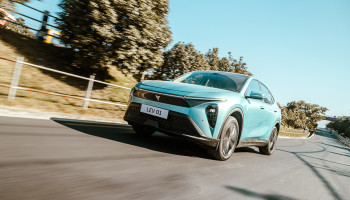
LS Auto LEV01: It’s a Start
January 24, 2025
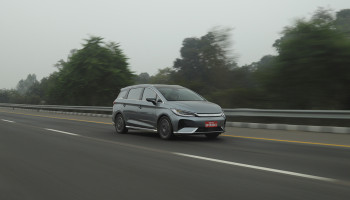
BYD M6: Beyond Limits - Day 3: Lucknow to Delhi
January 23, 2025
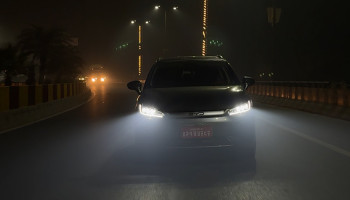
BYD M6: Beyond Limits – Day 2: Butwal to Lucknow
January 20, 2025



